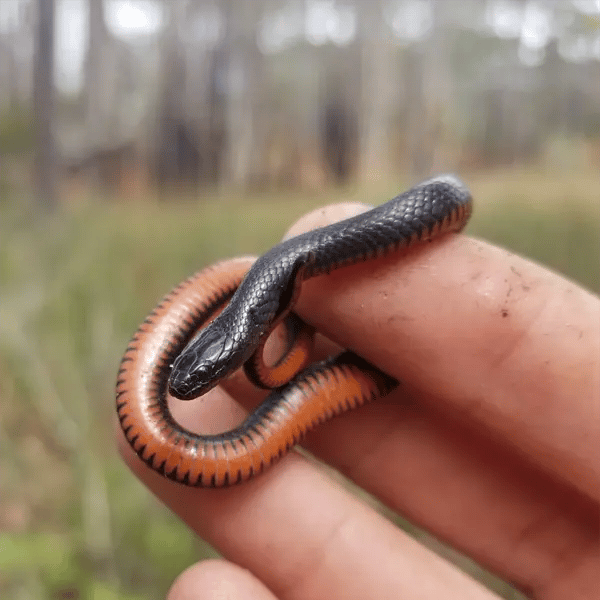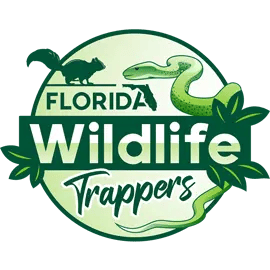Black Swampsnake
- Scientific Name
- Liodytes pygaea
- Also Known As
- Black Swamp Snake
- Range
- All of Florida, Except Near Pensacola
- Diet
- Small Frogs, Salamanders, and Soft-bodied Invertebrates
- Life Expectancy
- 7 - 10 Years
Quick Links
Black Swampsnakes in Central Florida
The black swampsnake (Liodytes pygaea) is a small, nonvenomous colubrid snake species found throughout the southeastern United States, including central Florida. Often confused with the reddish-brown Florida brown snake, the black swampsnake can be identified by its darker coloration, keeled scales, and other distinctive features.
This article provides an overview of black swampsnake biology, behavior, habitat preferences, potential risks, and prevention tips for central Florida residents who may encounter this native serpent.
Subspecies of Black Swampsnakes in the Area

Photo 35882091 © Rebecca W, CC BY-NC
Northern Florida Swampsnake
The Northern Florida swampsnake (Pygaea pygaea) is a subspecies found only in northern Florida and southern Georgia. Genetic isolation has led to unique traits, like their reddish belly color versus yellow in other swampsnakes. They also stay smaller, around 2 feet long, and have divided anal plate scales. Living in cypress swamps and marshes, their adaptations suit the habitat.
Calling them a distinct subspecies emphasizes protecting their habitat from further drainage. Preserving remaining cypress swamps and marshes in northern Florida allows this unique subspecies to survive. Recognizing their status brings attention to protecting the small isolated populations.

Photo 101035222 © cpgibson, CC BY-NC
Southern Florida Swampsnake
The Southern Florida swampsnake (pygaea cyclas) is a unique subspecies in southern Florida. Genetics show they diverged from other swampsnakes long ago. They stay under 2 feet long and have a yellow-orange belly unlike northern relatives. Southern swampsnakes also have divided anal plate scales. Living in marshes and swamps, they are adapted to the habitat.
Calling them a distinct subspecies stresses the need for habitat protection. Preserving remaining marshes in southern Florida is crucial for this vulnerable subspecies. Recognizing their status brings attention to safeguarding the small isolated populations and restoring lost wetlands. This allows the Southern Florida subspecies to recover.
Appearance and Identification
The black swampsnake can be distinguished from lookalike species based on the following juvenile and adult characteristics
The dark coloration, keeled scales, anal plate division, and other features distinguish this species from the reddish-brown Florida brown snake and other lookalikes.
Maturation Rate
The young grow rapidly with most maturation occurring in the first 1-2 years. Hatchlings quadruple in size within the first year. They develop adult coloration by 18 months old. Black swampsnakes can reproduce after two overwinter periods once attaining sufficient size and sexual maturity.
Habits and Behavior
The black swampsnake is a secretive, nocturnal species found near wetlands and marshy areas. They spend much of their time hidden under leaf litter, logs, boards, and other debris. When threatened, they may flatten their bodies to appear larger and give off a foul musk. Though nonvenomous, black swampsnakes may bite if handled.
These solitary snakes are more prone to flee potential threats. On land they move via serpentine crawling. Black swampsnakes are also excellent swimmers and will submerge completely underwater for minutes at a time if disturbed. Their natural camouflage and secretive habits make observation in the wild difficult.
Reproduction and Lifespan
Black swampsnakes mate from March to June. Females lay 3-22 eggs in July in concealed damp areas like under logs or clumps of moss. The hatchlings emerge in September to October. Black swampsnakes reach reproductive maturity after two years. Their average lifespan is estimated at 7-10 years.
Ideal Habitat and Range
Central Florida’s low-lying wetland regions provide optimal habitat for black swampsnakes due to the presence of:
- Freshwater marshes, swamps, and wet prairies
- Ponds, lakes, and slow moving streams
- Abundant moisture and seasonal flooding
- Dense stands of aquatic vegetation
- Accumulated leaf litter and debris
- Presence of prey like frogs, salamanders and insects
Their small size and cryptic habits allow black swampsnakes to thrive throughout these wet, low vegetation areas year-round. They retreat to higher ground and remain inactive during seasonal floods. The ample moisture and concealment satisfy their habitat requirements.
Diet and Feeding
Black swampsnakes are carnivorous, feeding mainly on small frogs, salamanders, and soft-bodied invertebrates like earthworms, slugs, and insect larvae. Juveniles start on smaller prey like slugs before progressing to larger items.
They locate food using chemical cues and are mostly nocturnal hunters. Prey is consumed alive and whole. These snakes kill by constricting prey within their coils.

Photo 30009244 © Neil Balchan, CC BY-ND

Common Health Risks
Black swampsnakes pose minimal health risks to humans. Their small size and reclusive nature make encounters and bites very unlikely. They are nonvenomous and not considered dangerous.
Minor swelling or irritation may result from defensive bites. Avoid handling wild black swampsnakes. Seek medical treatment for severe reactions to bites.
Preventing Black Swampsnakes
Black swampsnakes naturally avoid interaction with humans. Population control is unnecessary and relocation usually ineffective due to homing instincts. Simple preventive measures include:
- Eliminating standing water and debris piles around the home.
- Sealing foundation cracks and openings larger than 1/4 inch.
- Keeping yard vegetation short.
- Using snake deterrents like repellents, mothballs or predator urine.
- Exercising caution around water edges and under debris.
- Educating children and others to leave snakes alone if encountered.
Non-lethal removal using a long handled gripper can be done if snakes frequently appear on the property. Overall, coexistence works best with these harmless natural predators.
Black Swampsnakes in Central Florida – Conclusion
In summary, the black swampsnake is a small, cryptic nonvenomous species well-adapted to central Florida’s low-lying wetland habitats. They present little risk to humans and help control frog, salamander and insect populations.
Basic exclusion methods and avoidance is recommended if snakes are unwanted near homes. With education and proper identification, central Florida residents can coexist with this native reptile while admiring its unique natural history and place in local ecosystems.







